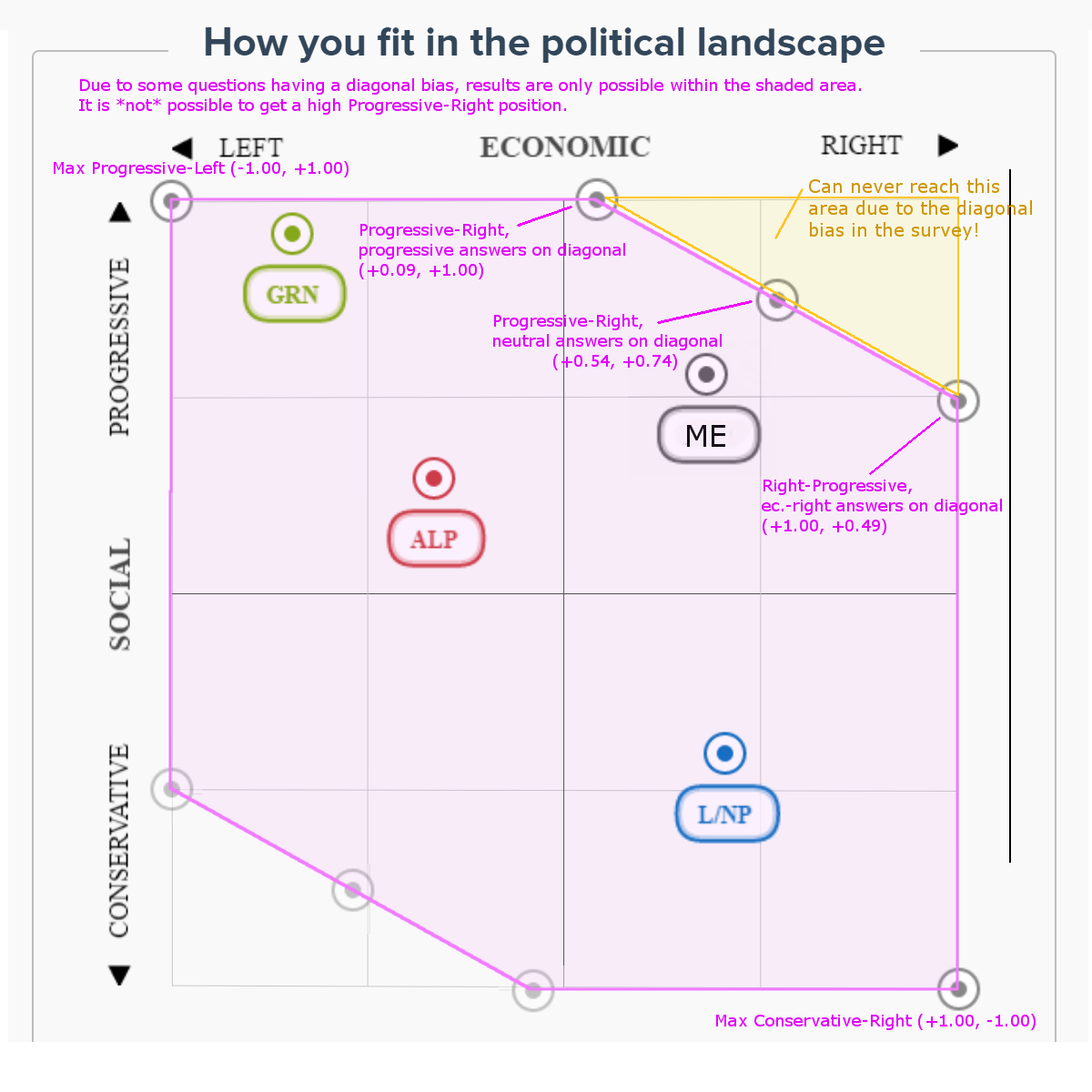For the 2016 election, the ABC Vote Compass has a diagonal bias embedded in some of the questions, reinforcing the major party axis and making it impossible to score highly (or lowly) in both economic freedom (Economic Right) and social freedom (Social Progressive) at the same time.
Due to the structure of the questions, final results are only possible within the shaded area, and can never reach the top right or bottom left corners.
EDIT (2016-06-23): It is possible to get in the top right (or bottom left) by answering "Don't Know" (rather than the middle answer) to the six diagonal questions. Results are scaled to only the questions you answer (this also scales the position of the parties to those same questions). The limitation applies if you answer every question. Also, the actual limit is slightly curved (not a straight line), as each question has a slightly different economic/social ratio, so it is actually possible to do slightly better than all-neutral answers.

Biased (diagonal) questions
Most questions move your result on either the economic or the social axis, however the following six questions (out of 30, i.e. 20% of the survey) move you on both the economic and social axis, but always in opposite directions. They make you either Progressive + Left or Conservative + Right, i.e. moving you along the diagonal.
- "Australia should put a price on carbon emissions."
- "Gender quotas should be used to increase the number of women in Parliament."
- "Schools with lower-performing students should receive more government funding than those with higher-performing students."
- "The federal budget deficit should be reduced, even if it means fewer public services."
- "The government should reinstate the construction industry watchdog, the ABCC."
- "The National Broadband Network should deliver faster speeds even if it costs the government more."
There are no existing questions that move you along the opposite diagonal.
The result of this is that the final score can never be in the top right or the bottom left corners, but only ever in the shaded area, with a bias along that diagonal. This makes alignment with the existing major parties appear more common than it is.
It also introduces an artificial (forced) correlation between the two axes; the above questions would need to be removed before any analysis of correlation of scores can be done.
Unclear reasons
It is unclear why some of the above questions are related to both the economic and social axis.
For example, what economic effect (left = controlled by the state, right = free markets) would gender quotas in Parliament possibly have?
Strange categorisation
Some of the questions also appear to be strangely categorised. At the time of the analysis, the question on assisted suicide:
- "Terminally ill patients should be able to legally end their own lives with medical assistance"
moved you along the economic (but not social) axis.
If you supported assisted suicide, then you were categorised as economic-left; if you were opposed, then economic-right.
It is difficult to see how this could be an economic issue, and is likely an error in the calculation. I have contacted the publisher with details of the issue.
Issues of freedom
While there were no questions in the system that produced a Progressive + Right diagonal movement (or the opposite), there are several issues that probably should be categorised that way.
For example, issues on foreign ownership, such as:
- "Foreign companies should be prohibited from leasing Australian ports", and
- "The government should further restrict foreign ownership of Australian agricultural land"
are both categorised as purely economic -- the way the questions are worded, as economic left if you agree.
However most of the opposition to foreign ownership is unlikely to be because people wish greater state control of the economy, but for similar reasons to opposition to refugees, i.e. a conservative dislike of foreigners who are different.
These two questions are clear examples of where agreeing with them should position you as Conservative + Left, along the opposite diagonal (and conversely disagreeing as Progressive + Right).
Another example, currently categorised as purely social, however also with economic effects is:
- "How involved should the Australian military be in the fight against Islamic State?"
Answering 'Much More' involvement of the military, whilst socially Conservative, also means the government is a larger part of the economy (military spending is entirely by the state), and so it should arguably be Conservative + Left (and the reverse Progressive + Right).
EDIT (2016-07-23): You can get to the top right
If you answer "Don't Know" to a question, then the results (both for you and for the parties) are scaled excluding that question.
By excluding the six diagonal questions, it is possible to get an answer in the top right corner (small-government progressive).
The original comments still apply if you answer all questions. This shows the importance of, for certain types of analyses, of excluding those questions.
Excluding the six diagonal questions adjusts the position of the parties towards the middle, as follows. Note that the scale in this graph, instead of +/- 1.0 in both dimensions, is actually Economic +/- 0.54, and Social +/- 0.74.

In closing:
It is not clear why the Vote Compass this year has this bias, or why it has apparent errors (when first released it also had the economic and social axes swapped) -- perhaps they were rushed for time with the early call of the election.
